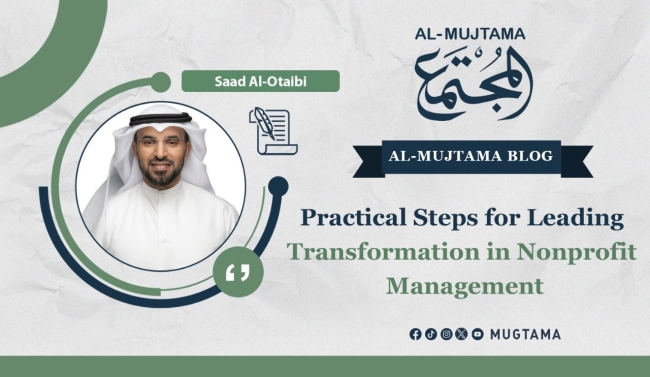In light of the increasing challenges facing nonprofit organizations, it has become essential for these institutions to adopt new methodologies that keep pace with developments and ensure the sustainability of their social impact. Leading transformation in nonprofit management requires a deep understanding of the current situation, a clear vision, and flexibility in dealing with change. In this article, we outline practical steps that can help nonprofit leaders lead transformation effectively and successfully.
Identifying the Need for Transformation and Assessing the Current Situation
Before initiating any transformation process, institutional leaders must conduct a comprehensive assessment of the current situation. This assessment includes identifying strengths and weaknesses, challenges facing the organization, and opportunities that can be leveraged for sustainable growth. Understanding the current status is the first step in building a successful transformation strategy. It is essential to analyze the organization's performance in terms of social impact, operational processes, and financial management to pinpoint areas needing improvement.
Setting a Clear Vision and Transformation Strategy
The next step is to craft an ambitious transformation vision. This vision should be realistic, achievable, and aimed at improving the organization’s social impact and operational efficiency. Leaders should set clear objectives that cover areas such as service development, enhancing communication with donors, and improving financial performance. This vision requires an implementation plan that includes short- and long-term goals, along with defined timelines to ensure gradual and sustainable transformation.
Motivating and Developing the Leadership Team
Effective leadership is the cornerstone of transformation. Therefore, leaders must strengthen the management team's capabilities through necessary training and motivate everyone to adapt to change. Having a qualified team capable of implementing transformation is key to success. It is also essential for leadership to be collaborative and open to diverse opinions, as this enhances harmony and reduces potential resistance to change.
Engaging Stakeholders
Transformation cannot succeed without engaging the organization’s stakeholders. It is crucial to communicate effectively with all employees, volunteers, beneficiaries, and donors to explain the transformation vision and highlight the importance of this step in achieving the organization's goals. Involving everyone in the process increases support for change and helps reduce resistance that may arise from fear of the unknown.
Embracing Innovation and Technology
Successful transformation in any organization cannot be achieved without investing in innovation and technology. Technology helps improve the efficiency of operational processes and deliver services faster and more effectively. Nonprofits should adopt tools such as project management systems, digital financial systems, and enhance their communication with the community through social media platforms. Innovation opens new horizons for resource development and increases the organization’s impact.
Gradual Change Management
Transformation does not happen overnight. Success requires implementing steps gradually, with leaders developing an execution plan that includes defined phases of transformation. These phases can start with small changes, such as improving operational efficiency, and then expand gradually to include broader cultural and organizational transformation. Continuous evaluation of progress is crucial to ensure the organization is moving in the right direction.
Communication and Transparency
Finally, continuous communication and transparency with all parties are essential to maintaining trust throughout the transformation process. Management should be transparent about the challenges and successes and establish a mechanism for receiving feedback from employees and other stakeholders. Promoting this culture ensures that significant resistance to change does not arise and fosters a positive work environment that encourages innovation and development.
In conclusion, leading transformation in nonprofit management requires meticulous planning and careful execution. If the steps mentioned above are followed, along with a clear strategic vision, leadership team development, innovation adoption, and effective communication, the transformation will lead to improved organizational efficiency and enhanced social impact. This transformation is not just a necessity for survival but also an opportunity for growth and expansion in serving the community and achieving noble charitable goals.
-------------------------------------------------------------


